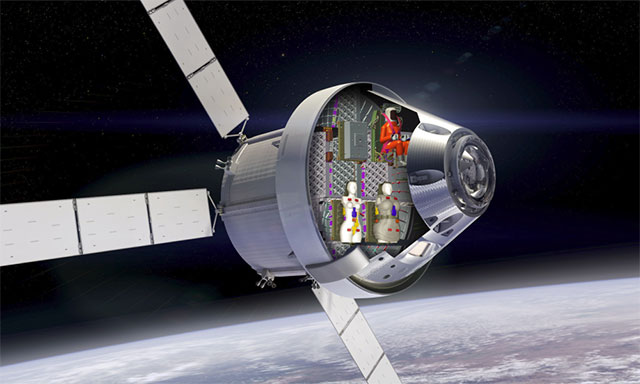How the Orion spacecraft is being protected from extreme radiation
When NASA's Artemis I mission successfully launches and begins its journey around the moon in 2022, there will be no astronauts on board — instead, there will be two adult-sized mannequins. The dummies, named Helga and Zohar, were designed to test the radiation levels astronauts might be exposed to when they fly Artemis II and III.
After nearly two years of data collection and analysis, the German space agency DLR has released the first results from its space radiation study. The good news for future lunar explorers is that it appears that the radiation levels they will face will be within acceptable limits inside the spacecraft's properly shielded areas.
Radiation is one of the biggest concerns as humans move beyond Earth's protective atmosphere and the region of charged particles known as the Van Allen belts that help protect all life on Earth from harmful radiation. Once out of low Earth orbit, toward the moon and beyond, astronauts will be exposed to extreme levels of radiation that can cause cancer, heart disease and a host of other health problems.
New research from DLR finds that radiation exposure inside the Orion spacecraft varies significantly depending on location, with shielded areas offering up to four times better protection than unshielded locations.

But it's not just the environment inside the capsule that matters. The study also found that the orientation of the spacecraft affects exposure levels. For example, turning the spacecraft 90 degrees while flying through the inner Van Allen belt reduced radiation exposure by 50 percent.
' This indicates that this flight maneuver can significantly reduce the crew's radiation exposure. This is also a good sign and confirms the basic suitability of Orion for future human spaceflight. Our measurement data also provide a solid knowledge base for the design of such missions ,' said Dr Thomas Berger of the DLR Institute of Aerospace Medicine.
Two dummies were used to simulate the types of radiation exposures the human body might encounter, comparing an unprotected dummy to a dummy wearing a radiation suit. The researchers have not yet published the data from that comparison, but the analysis promises to yield some interesting insights.
With radiation monitoring instruments placed throughout the Orion capsule, we are gaining valuable insights into how space radiation interacts with the spacecraft's shielding, what types of radiation penetrate to reach the human body, and which areas of Orion provide the best protection. This knowledge is invaluable as it will allow us to accurately estimate radiation exposure for ESA astronauts before they travel into deep space, ensuring their safety on missions to the Moon and beyond.
You should read it
- Admire incredibly detailed images of the Orion Nebula through the eyes of the James Webb telescope
- Russian spacecraft 'resupply' successfully 3 tons of cargo for the ISS in just 3 hours
- The meteor glows and dissolves leaving a golden light trail winding in the sky of Japan
- Watch live the first SpaceX spacecraft launch event
- NASA wants to make spacecraft parts right on low Earth orbit
- 8Pack Orion X2 - What's the special $ 40,000 supercomputer?
 World's most expensive space telescope captures the moment two galaxies are about to collide
World's most expensive space telescope captures the moment two galaxies are about to collide 5 Examples That Prove AI Content Checkers Are Useless
5 Examples That Prove AI Content Checkers Are Useless Which animal gives birth to the most children?
Which animal gives birth to the most children? Find out why your hard drive is showing the wrong capacity
Find out why your hard drive is showing the wrong capacity Suggestions on how to fix computer error please wait
Suggestions on how to fix computer error please wait What to do when Startup Repair takes too long?
What to do when Startup Repair takes too long?